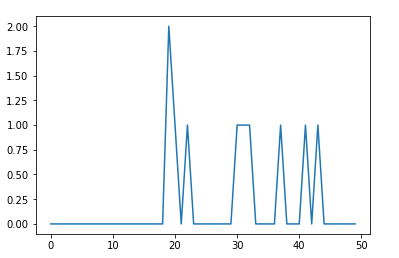NumPy: Compute the line graph of a set of data
Generate Line Graph of Data
Write a NumPy program to compute the line graph of a set of data.
Sample Solution:
Python Code:
# Importing the NumPy library and aliasing it as 'np'
import numpy as np
# Importing the matplotlib.pyplot module and aliasing it as 'plt'
import matplotlib.pyplot as plt
# Generating a NumPy array 'arr' with 10 random integers between 1 and 50 (excluding 50)
arr = np.random.randint(1, 50, 10)
# Creating a histogram with np.histogram()
# 'y' stores the frequencies, 'x' stores the bin edges using np.arange(51) (from 0 to 50)
y, x = np.histogram(arr, bins=np.arange(51))
# Creating a figure and axis using plt.subplots()
fig, ax = plt.subplots()
# Plotting the histogram by plotting the bin edges against frequencies
ax.plot(x[:-1], y)
# Displaying the figure
fig.show()
Sample Output:
Explanation:
In the above code –
arr = np.random.randint(1, 50, 10): This line generates an array of 10 random integers between 1 and 49 (inclusive) using np.random.randint() function.
y, x = np.histogram(arr, bins=np.arange(51)): This line computes the histogram of the random integers using np.histogram() function with bins from 0 to 50 (51 bins in total). y will contain the frequency counts for each bin, and x will contain the bin edges.
fig, ax = plt.subplots(): Create a Matplotlib figure and axis object using the plt.subplots() function. This will be used to create and customize the line plot.
ax.plot(x[:-1], y): Plot the histogram on the axis object ax using the ax.plot() function. Since x contains the bin edges, we use x[:-1] to exclude the last bin edge and match the length of y.
Finally fig.show() function displays the line plot of the histogram with the bins on the x-axis and their corresponding counts on the y-axis.
For more Practice: Solve these Related Problems:
- Write a NumPy program to generate a line graph from a sequence of data points and display it using matplotlib.
- Create a function that takes an array of x-values and y-values and plots them with custom labels.
- Test the graph generation on synthetic data and verify that the line graph accurately represents the trends.
- Implement a solution that overlays multiple line graphs on the same plot for comparative analysis.
Go to:
PREV : Compute Histogram of Data
NEXT : Find Index of Higher Ranked Value in Array
Python-Numpy Code Editor:
Have another way to solve this solution? Contribute your code (and comments) through Disqus.What is the difficulty level of this exercise?
Test your Programming skills with w3resource's quiz.

